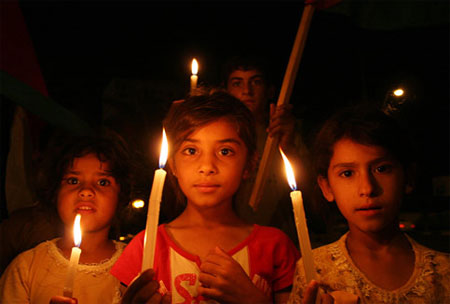L'énergie à la bougie devient le quotidien des habitants de Gaza
Self-help Gazans still need outside world
JERUSALEM, 15 October 2007 (IRIN) -
The continuing power cuts in Gaza have made candles a basic necessity, but many residents can no longer afford them.
Ahmed Asidawi, aged 42, has been mostly unemployed since the start of the Palestinian uprising in September 2000 and he is barred from entering Israel to seek work. He is a refugee registered with UNRWA, the UN agency for Palestinian refugees.
"I don't have money to buy candles. I get aid from the agency. I am registered as a special hardship case. I have no other source of income," he told IRIN from Nussairat refugee camp in central Gaza. Najwa Sheikh Ahmed and her husband Taher, also residents of Nussairat, recently began a campaign to help their poorest neighbours.
Najwa's job with UNRWA brought her into contact with international aid workers who are able to exit and enter the Gaza Strip, a luxury few Palestinians have enjoyed since June, when, following bloody battles which left the Islamic group Hamas in control of Gaza, the borders were sealed.
She asked international friends and their colleagues "on the outside" - a phrase used to describe everywhere but the enclave - to buy candles and bring them to Gaza. Conventional imports into the Strip are restricted. She and Taher then distribute the candles in the camp.
"It was an idea to help my people. I don't have money to give. This idea is simple but can help," she told IRIN.
Najwa said she felt the need to do something after the sudden, but temporary, end to European Union-funded fuel for power generators in August, which plunged Gaza into the dark for several days. Since an Israeli airstrike on Gaza's power station last year, electricity in the Strip has been generally unstable.
"We need help from the outside"
Najwa's candle initiative relies on the connection to the outside world she maintains through foreign aid workers. It highlights, observers said, the impact of the sanctions in place on Gaza and the need for the enclave to resume contact with the outside world.
Fida Qishta, a resident of the Rafah District in southern Gaza, began a programme in 2003 to help the traumatised children of the area who have seen more than their fair share of violence in recent years.
"We saw children suffering, children without a childhood. Young girls talked like 20-year-old women," she said. In the area closest to the border, the children could only talk about tanks, bullets and guns, she added. Her children's groups have grown from four children per group to over 70. More than 400 youngsters have undergone some sort of educational therapy through her Life Makers Team in the past few years.
The project was a local one, relying on volunteers and a "fee" of a dollar a month from the parents of the children. "The economic situation is so bad. Even one dollar is too much now. One father said to me 'if I don't make a dollar, how can I give you one'," Qishta told IRIN from Rafah, with its 150,000 residents, most of them refugees.
She has come to rely on foreign donations, typically from individuals in the USA. "To get anything big running, we need help from the outside," she said, adding that she was now trying to raise money to build Rafah's first playground.
"The children need more green. Life is too black", she said.
The closures on Gaza have also affected her other projects which generated income for the poor.
"The women from our centre made handicrafts and sent them abroad, to places like France - bags and wallets in a Palestinian embroidery style. Now we can't. The raw materials are out of reach and anyway we can't export the finished product," Qishta said.
Najwa, for her part, also noted the heavy price paid by the most vulnerable.
"My son came home from school saying children in his class didn't have notebooks or pencils, because their parents couldn't afford them. I want to launch a new campaign, to bring in more school bags and equipment, like pencils and pens, for these children," she said.

